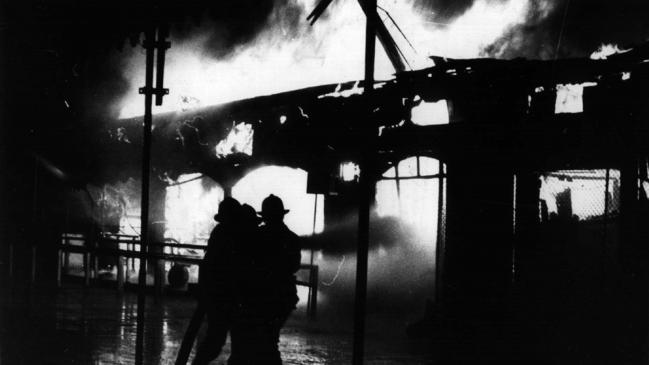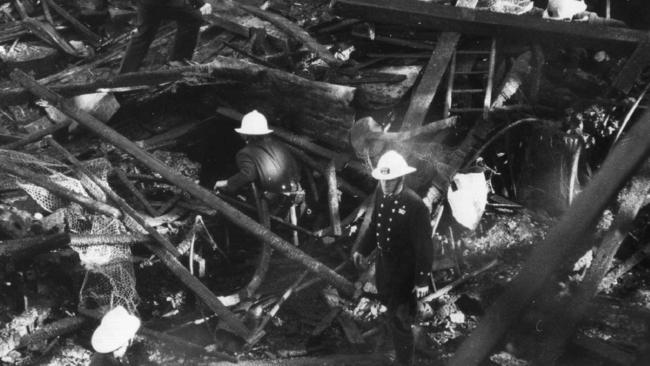
I watched the series with interest as it culminated in a bizarre and convoluted conspiracy which tied Abe Saffron to the NSW Premier Neville Wran.
My colleague, Troy Bramston, has written extensively refuting that conspiracy.
My curiosity with the documentary lies elsewhere on the journalistic investigation that omitted key facts on the circumstances of the fire. This was a central point of the documentary because all of its assumptions fall away if the fire was not deliberately lit. While questions remain, there is no proof of arson to any legal standard.
Most of the ABC documentary’s assertions were not particularly revelatory. Fairfax ran the story, accusing Saffron of being the architect of the Sydney Ghost Train fire nine months after his death in 2006.

It led to a number of successful lawsuits for defamation, the most notable undertaken by Tosha “Todor’’ Maksimovich, an employee of Saffron’s The Sunday Age described as a professional arsonist who had lit the fire at Luna Park. Maksimovich had only to produce his passport which proved he was overseas at the time of the Luna Park fire and the Fairfax newspaper was obliged to make a grovelling apology and reach for the cheque book.
One can only presume that the participants of the documentary, including eye-witnesses and grieving parents and siblings of those who died in the fire were aware of these stories as they were first reported more than a decade ago although this is not made clear in the documentary.
The real scandal of the Luna Park Ghost Train fire and one based on established facts was that the deaths of six children, Damien and Craig Godson, Jonathan Billings, Richard Carroll, Michael Johnson, and Seamus Rahilly and one adult, the father of Damien and Craig, John Godson, were entirely avoidable.
Various eye-witnesses including those who were operating the ride described the fire as an inferno which it most certainly was. Explosions were heard. The fire, it was said, “didn’t look normal.”
In findings made by Coroner Kevin Anderson in 1979, the building was described as of “mainly timber construction, the external walls were mainly timber with corrugated iron at the northern end, the internal partitions were of hardboard plywood and wood. The roof was of timber overlaid with layers of bitumen impregnated building paper and was finished on its top surface with hot mopped bitumen, part of the roof was of corrugated iron. Expert evidence is that once the fire had begun and involved the roofing materials, the spread would be very rapid, the heat would be intense and very dense smoke would be developed.”

One serious omission in the program was that NSW Board of Fire Commissioners had, through the North Sydney Council, directed the management of Luna Park to carry out fire prevention work in 1977 which included the provision of illuminated exit signs at the escape doors, the installation of safety emergency lighting and the installation of a fire hose reel system with hoses of sufficient length to reach all areas of the park.
Park management were given 18 months to carry out these works.
A month before the fire, North Sydney Council allowed park management a further 12 months to carry out the work.
The instructions were issued on the basis that any time the ride was in operation, one attendant would be inside to provide patrons with direction in the event of an emergency. It is clear this was not the case on the night of the fire.
One of the three internal exit doors had been blocked off and was used as storage for the ride’s surplus carriages.

Put simply, the ride was a death trap and the attendants were ill-prepared, poorly resourced, and untrained on safety measures in the event of a fire.
These are matters of fact, established by the Mr Anderson in 1979. They were not examined, barely raised or not at all by the ABC documentary.
The allegation that the fire was started by bikies in the employ of Saffron was also examined by a NSW police internal security unit over a period of months in 1985 with police determining the evidence was insufficient to reopen the investigation.
The coroner returned an open finding which surmised the fire may have started from a lit cigarette discarded into flammable materials at or around a location of the ride where a fake fire exhibit was in place.
The ABC documentary program was able to find people who smelled kerosene. One eyewitness had referred to it in his statement to police after the fire. One other, one of the ride operators, had not. While that evidence should have been put to the coroner, whether kerosene is a discernibly distinct odour to the cocktail of petrochemicals on the walls and in the roof once the structure was alight is at face value a leap of logic.
That cocktail came from the blazing bitumen, a highly viscous, petroleum-based hydrocarbon, the paint of the walls was oil based as was the phosphorescent paint on the exhibits.
The documentary was able to establish serious deficiencies in the police investigation. The first was that NSW Police with the lead investigator Detective Inspector Doug Knight had informed the media the cause of the fire was an electrical fault. On expert evidence the coroner rejected this.

I’d argue that just about every major investigation undertaken by the NSW Police in that era was tarnished in some way or another.
Four years earlier, Juanita Nielsen disappeared in Kings Cross. Her body has never been found and no one was charged with her murder.
The so-called Sydney Gang Wars of 1984-85 led to numerous murders, most of which remain unsolved or in the rare cases where charges were laid, convictions were not obtained.
It would be wrong to suggest that all senior police in the New South Wales Police Force were corrupt at the time of the fire, but the effect of top down corruption was to create a sort of investigative malaise where mistakes were common.
While these were pre-conditions for investigative failures, they do not of themselves prove the documentary’s central point, that the fire was deliberately lit.
The first episode of the documentary featured the grieving parents of the deceased children, the grieving wife of John Godson and mother of their two children. It was a treatment handled with great sensitivity that spoke of enduring heartbreak, an anguish undiminished by the passage of more than 40 years.
But as the program wore on into its culmination, I was left to wonder if these people had been led to a place where they could never return, based on assumptions that as they stand cannot be proven in a court of law. If so, it is an unimaginable cruelty for no good purpose.
The only way forward now is to establish a new coronial inquiry to examine evidence again, to hear the evidence that was not put to the coroner in the first place and to take the time to give the grieving some closure at last.







Last month, the ABC screened a three-part investigative program into the Sydney Luna Park Ghost Train fire on June 9, 1979, led by journalist Caro Meldrum-Hanna.